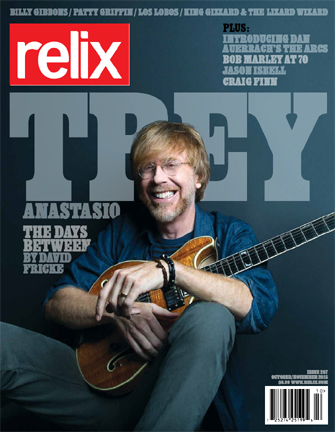Trey Anastasio: Lessons from Dead Camp
The October_November issue of Relix features David Fricke’s cover story on Trey Anastasio in which Anastasio discusses his role in the Fare Thee Well shows with the members of the Grateful Dead, as well as his ongoing efforts with Phish and his new solo album, Paper Wheels. Relix subscribers will receive the issue shortly (and if you’re not a current subscriber but you sign-up by 10/29 you’ll receive the issue). The October_November Relix is also available for online order.
“OK,” Trey Anastasio says, leaning across a table in a New York café with a delighted gleam in his eyes, “here are four things I learned at Dead Camp.”
Dead Camp is the Phish guitarist’s euphemism for the first half of 2015, his short but intense spell as a working member of the band that has been a constant spiritual presence and creative challenge in his life since he was a teenager: the Grateful Dead. On January 5, Anastasio was in Miami, having just finished Phish’s annual run of New Year’s-week concerts, when he received an email from Phil Lesh, the Dead’s bassist, asking him to join him and the other surviving members of that group—guitarist Bob Weir and drummers Bill Kreutzmann and Mickey Hart—for a series of July 4th weekend reunion performances at Soldier Field in Chicago.
The concerts, dubbed Fare Thee Well, would commemorate two profound events, the 50th anniversary of the Dead’s founding in 1965—in the embryonic ferment of psychedelic San Francisco—and the 20 years since their final show—in that venue, on July 9, 1995—with Jerry Garcia. The band’s founding guitarist and all-but-official helmsman, Garcia died a month later, on Aug. 9, of a heart attack after a lifetime of battles with drug addiction, weight problems and diabetes. He was 53.
Anastasio—who saw his first Dead concert at 15, in May 1980 at the Hartford Civic Center in Connecticut—quickly accepted the invitation, then withdrew from all of his other musical work, including Phish and his Trey Anastasio Band. For the next five months, the guitarist, 51, embarked on a thorough, monk-like immersion in Garcia’s signature tone, expressive vocabulary and improvisational drive across a 30-year body of studio and live recordings. By mid-June, Anastasio was rehearsing in Northern California with the Dead and their other guests for this run, keyboard players Bruce Hornsby, a touring member of the Dead in 1990-92, and Jeff Chimenti, a regular presence in Dead-member projects. The education peaked—with transcendence—at two preview gigs on the Dead’s home turf, on June 27 and 28 at Levi’s Stadium in Santa Clara, Calif., then in Chicago on July 3-5.
“I was always telling the guys in the Dead—I learned so much,” Anastasio says earnestly over breakfast on a recent late-summer morning, in a breakneck two-hour conversation regularly punctuated by staccato laughter and declarations of gratitude. “This is just four of the things I got from the experience. I already knew them,” he points out, grinning. “But now I really know them.”
The first: “There has never been a great rock band that hasn’t been built around an irreplaceable drummer,” Anastasio says. “That guy, in the Dead, is Bill Kreutzmann. I stood there for five days, watching people dancing. Bill is the heartbeat—Mickey, too. Together, they are one heart. Once the music started”—Anastasio hums the opening riff of “Truckin’,” the first song on the first night in Santa Clara—“I was like, ‘I know who’s driving this ship.’”
The second lesson: “Bobby is Mr. Slow Down,” Anastasio goes on. “He is patient, comfortable—no rush. Sometimes I’d be like, ‘You really want to play this song that slow?’” When Anastasio played the entrance lick in “Deal,” the last song of the first set on July 4, it was “at a Jerry Garcia Band tempo from 1982.” It was also “a little too fast.” When the song was over, Anastasio walked over to Weir. “I said, ‘That was too fast, wasn’t it?’ He said, ‘Yeah.’ But he was totally cool. He played it anyway.”
Something else Anastasio discovered about Weir: “He’s a rock singer. Sometimes the music would get loose, a little floundering—no one knows where it’s going to go. Then Bobby would step up, like in ‘Samson And Delilah’”—in the first set on July 5. “When he started singing like that, boom, 80,000 people came together. It didn’t matter if it was in tune. That wasn’t the point. I could feel him unifying that stadium.”
Anastasio’s fourth revelation at Dead Camp: Forget the clock. “I love to jam,” Anastasio says brightly. “I love to jam long. But even for me, the time would come when I’d think, ‘This is too noodle-y. Let’s play the next song.’ I would do something, a lick, that gently alluded to it. Then Phil would look over at me and put his hand up, like, ‘What’s your rush, dude?’
“They weren’t done,” Anastasio concedes cheerfully. “That thing from the Acid Tests”—the 1965 and ‘66 LSD communions in San Francisco that were among the Dead’s first gigs—“was still there. ‘We’re not here to entertain you.’”



















